As a kid, sure, I wanted be an insect expert like Jean-Henri Fabre. But I didn’t eat bugs. This fresh young man does—he practices entomophagy—and our chat over tea was full of the unexpected.
ーSeiko Ito
I liked insects so much that I couldn’t keep myself from eating them.
Yuta: For starters, please try my favorite tea, it’s made from cherry caterpillar droppings.
Seiko: What a distinct flavor. I like it. And here comes the bitterness, just like tea.
Yuta: How bitter the tea is depends on how you brew it. The bitter aftertaste creates a nice accent. It makes the perfect follow-up to sweet desserts.
Seiko: Are these black pellets the caterpillar droppings? The ones over here are green.
Yuta: Those are silkworm droppings.
Seiko: I was interested in silkworms and tried rearing them twice. I remember they pooed all the time, but I don’t recall their poo being such a vibrant green.
Yuta: These caterpillars were reared exclusively on mulberry leaves. In China, silkworm droppings are called sansha and taken as a traditional medicine. It’s believed to promote blood flow and be gentle on the intestines. Best of all, it has an alluring taste. We use it in many drinks and desserts at the restaurant.
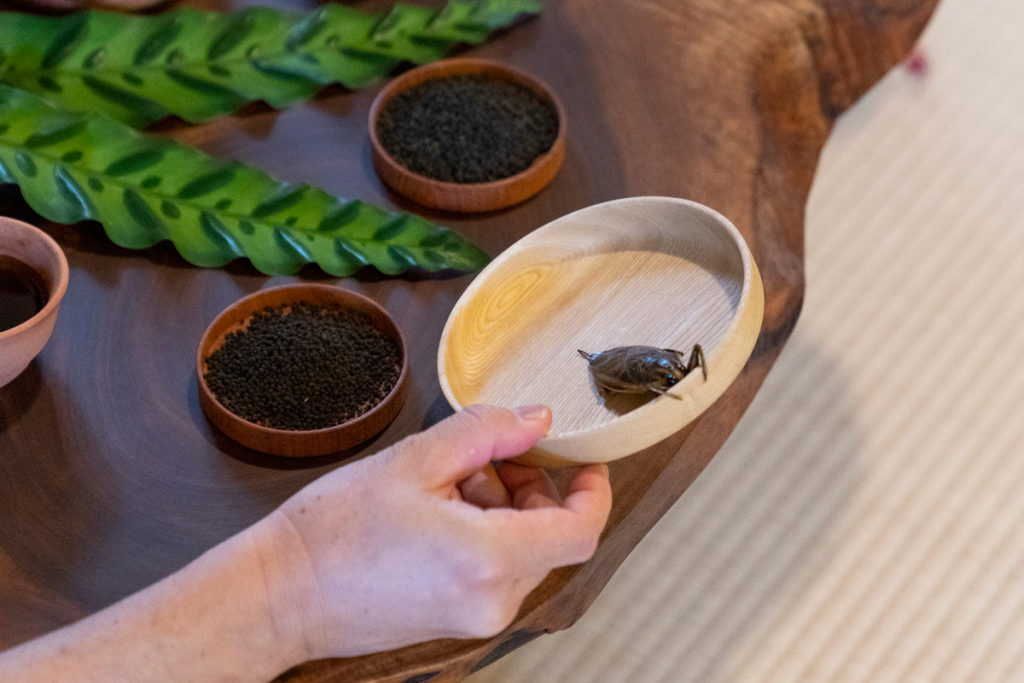
Seiko: Were you first a cook who then acquired a taste for bugs? Or was it the other way around?
Yuta: For me, it’s always been bugs first.
Seiko: My parents are from Nagano Prefecture, so I was familiar with the custom of eating locusts. As a kid, I was encouraged to catch grasshoppers at the river. My parents then ate them roasted. I liked insects, and for that reason, I never ate them. I thought that was the logic with all insect lovers. But you went ahead and ate them without reservation?
Yuta: I guess I liked insects so much that I needed to gobble them up as an act of love. Ever since I could remember, I was catching every bug in sight and popping it in my mouth.
Seiko: Wait! Bugs can carry roundworms. I hope you broiled or boiled them first, just in case.
Yuta: Back then, I ate them raw. Now I understand the risk of contracting parasites and cook all insects thoroughly. But I learned so much about insects by eating them. The first cherry caterpillar I ever ate tasted like a delicate sakuramochi. I was a kindergartener. It blew me away.
Seiko: Didn’t the hairs sting?
Yuta: Those hairs aren’t toxic. Some caterpillars have hairs that contain powerful toxins, like the tea tussock moth, but the cherry caterpillar is the larva of the buff-tip moth, and it won’t cause a rash. Best of all, the flavor and texture are excellent. I thought about my experience a great deal, and it made sense. If the caterpillar ate nothing but cherry leaves, of course it would taste like a pink rice cake wrapped in a pickled cherry leaf. That was my eureka moment. All living beings eat food and are fed on by other beings. The cycle goes round and round, and I remember feeling content that my life was part of it.
Seiko: Okay, but I bet you didn’t have any friends who said I eat bugs too.
Yuta: No, not a single one. I once caught an insect and took it to kindergarten, and the teacher scolded me for bringing a dirty bug into the classroom. I got the general feeling not everyone likes bugs. There was no way I could reveal that I ate them.
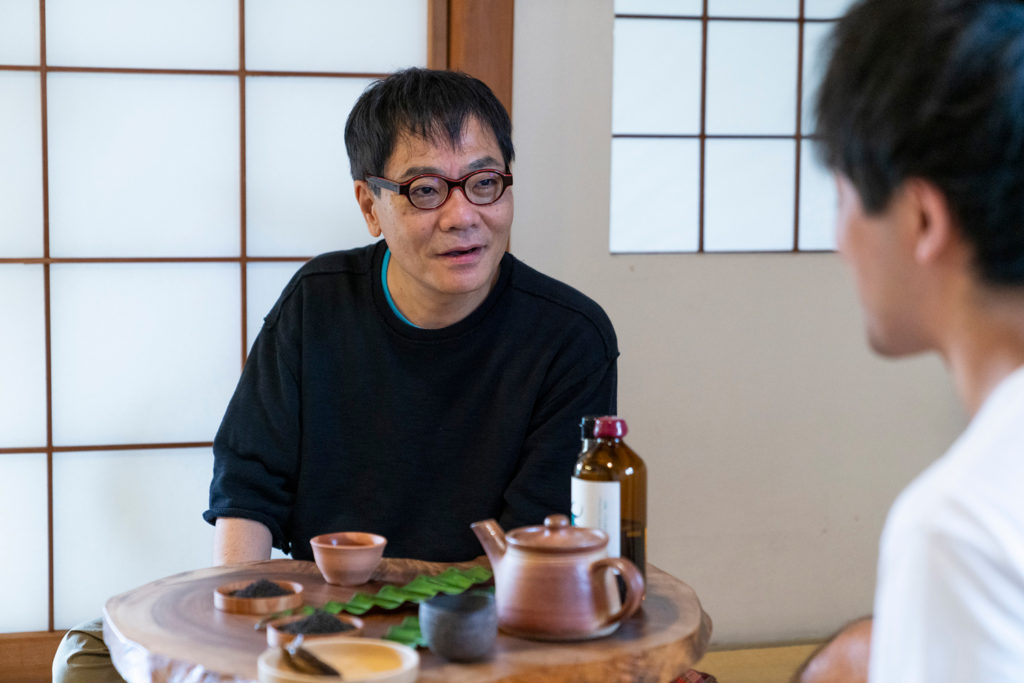
My first friend was the United Nations
Seiko: Weren’t you afraid of poisoning yourself?
Yuta: Actually, that was part of the fun. I felt a strong stinging sensation when I ate a millipede, for instance, and as it turned out, millipedes were venomous.
Seiko: How could you eat a millipede!?
Yuta: My picture book didn’t discuss the nature of the millipede’s venom or what effect it might have on the human body. So I tried it, and through firsthand experience, I felt I had become one with nature.
Seiko: I see. You’re right, no picture book deals with insects as food. That information would offer a valuable lesson about nature though. Even birds must have preferences, you know. The warbling white-eye, for instance, must eat one bug more than another. I’m 60, and my generation didn’t think too lowly of insects, but there was a point when the mood switched, and insects became unclean.
Yuta: Cockroaches weren’t always pests. They were made out to be pests by insecticide makers, who needed to promote the dirtiness of the target in order to sell their products.
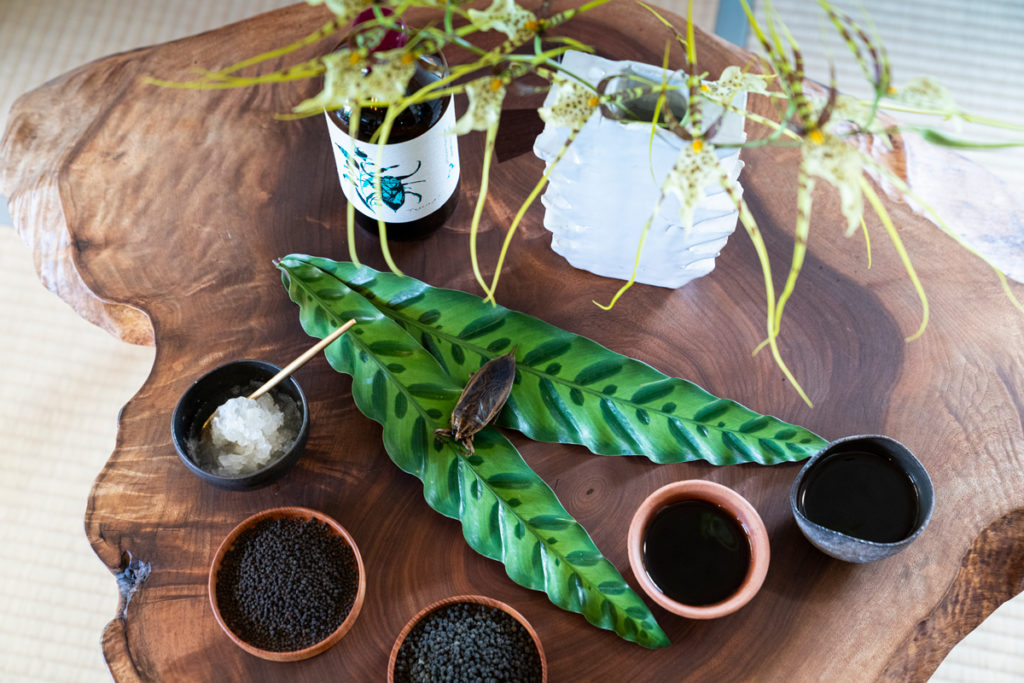
Seiko: When did you discover you had a friend?
Yuta: My first friend was the United Nations. When I was around 19, the Food and Agricultural Organization published a report saying insects were part of the solution to the global food shortage. The shocking report made the news around the world. I felt my cause was justified.
Seiko: Insects have potential. They have a future. You felt it was okay to go public. Who did you first come out to?
Yuta: I started out by sharing articles on social media that encouraged and promoted entomophagy.
Seiko: And someone came forward and agreed with you?
Yuta: No, not at first. Many reactions were along the lines of I don’t get it and gross!!!
Seiko: So there was more oppression.
Yuta: After mustering up all my courage and coming out with a 19-year-long secret, I thought about taking back everything. But then a small number of people got in touch saying they ate insects when they were children, and they were interested in doing so now. I started taking these people to the mountain with me and showing them which insects are edible.
Seiko: You shared your treasure trove of delicious treats.
Yuta: Initially, I was satisfied just to find people willing to try the insects, but in time, I wanted them to enjoy the flavor more. Up to then, I believed the straightforward taste of the ingredient was best, and cooking it was uncool.
Seiko: Your perspective changed from preparing the insects raw to getting creative and blending them with soy sauce.
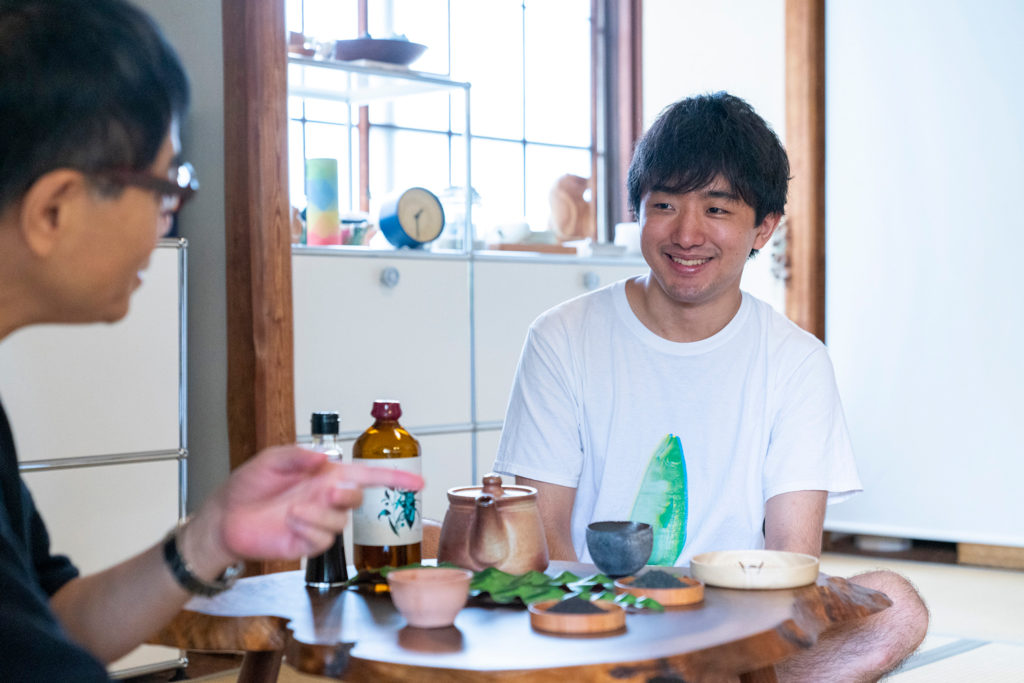
The turning point was Cricket Ramen
Yuta: The problem was, I couldn’t cook at all. I called for collaborators on social media and began working with curious cooks to make all kinds of experimental insect dishes. The greatest turning point was the Cricket Ramen I jointly invented with Ramen Nagi. The soup stock is made from crickets, and the dish created such a buzz that customers were waiting in line at the noodle shop to try it.
Seiko: With soup stock, I imagine the visual aversion was minimal. How about the taste? Are crickets exceptionally good?
Yuta: The taste is similar to shrimp or dried sardine. Our minds weren’t made up to use cricket from the start though. We tried 20 or 30 species of insect. Some didn’t create any flavor at all. Others turned out bitter. In the end, crickets were easy to come by because they’re farmed for pet food. And we Japanese enjoy the cricket’s chirping song in autumn, so I figured the disgust factor would be relatively low.
Seiko: To make the stock, do you use the crickets raw or cooked?
Yuta: We dry the crickets for a short period of time and then roast them. Curiously, crickets are omnivorous—they eat a varied diet of meat, vegetables, fruit, and fish. So the taste of the cricket depends on what you feed it. The Tokushima brand of cricket is reared on waste yuzu, for instance, and it has a subtle citrusy scent.
Seiko: The flavor migrates. No wonder they feed sudachi to beef cattle.
Yuta: Exactly, only this is the same idea applied to crickets. Insects have simpler digestive systems, so what they eat reflects more directly in the taste. By rearing them on food waste, we could help reduce waste and promote a circular economy.
Seiko: I bet insects play a significant role in synecoculture—the farming method that makes use of natural ecosystems.
Yuta: That perspective alone suggests we should eat insects to save limited resources, or as a substitute for some other resource facing depletion. But that makes me uncomfortable—I eat insects for pleasure. I’m hoping to promote a purer approach, where we have more fun and play with the flavors and warm people up to the concept of entomophagy, so that it might be a more welcome choice.
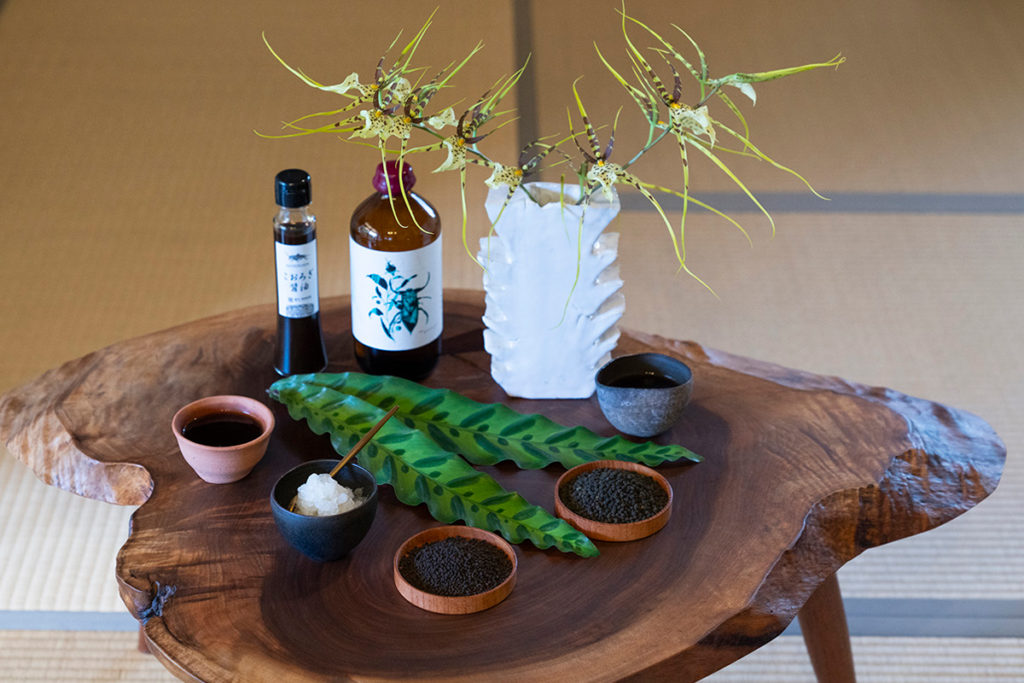
Japanese Fika Table
Tea | Cherry Caterpillar & Silkworm Droppings Tea
Fresh droppings are collected, carefully dried and heated, and infused for about 5 minutes to prepare the tea. Cherry caterpillar droppings are black; silkworm droppings are green. Cups by Ayako Terasaki and Takayuki Watanabe.
Sweets | Shaved Ice with Giant Water Bug Syrup
The syrup with a pear-like aroma is extracted from the Lethocerus indicus species of giant water bug that Yuta purchased at a market in Thailand. The essence is a pheromone released by males to attract females. Bowl by Etsuji Noguchi.
Flower | A Landscape Evocative of Insects
Brassia is native to tropical America and also known as the spider orchid owing to its spectacular shape. Calathea leaves decorate the table. Vase by Kanako Nakano (Birbira).
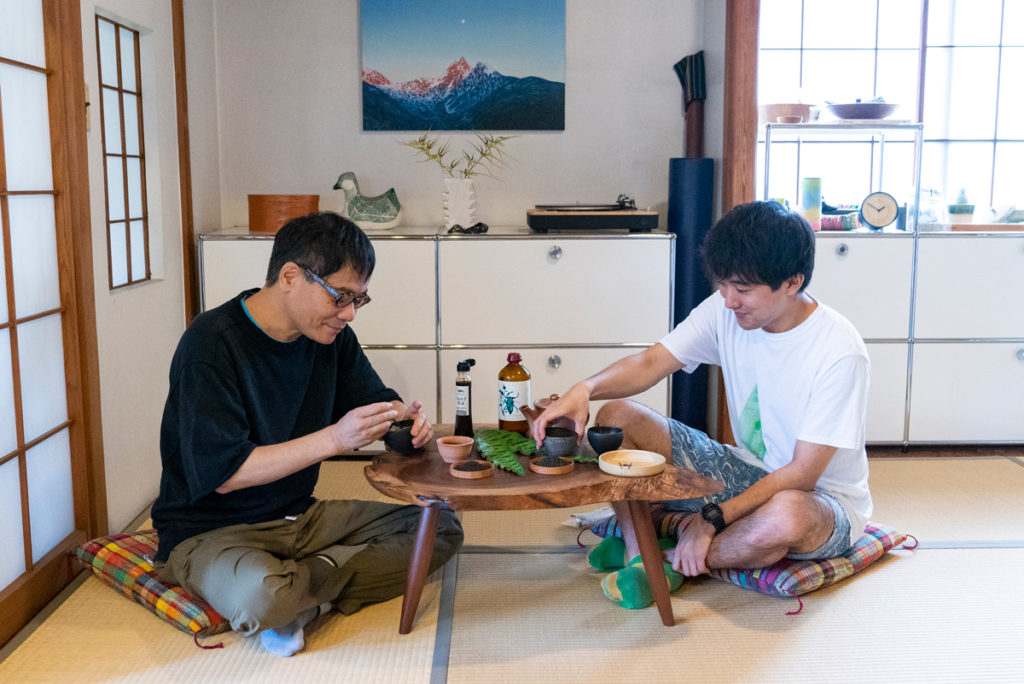
Yuta Shinohara, The Earth Boy
Yuta Shinohara was born in 1994 in Hachioji City, Tokyo. He is a graduate of Keio University and has been practicing entomophagy—eating insects—for 23 years. He lived near Mt. Takao as a child and started tasting the bounties of the wild in the river and the mountain. While in university, he shared information on edible insects and organized events serving dishes made with them. In 2020, he opened the edible Earth restaurant ANTCICADA and began serving insects, wild grass, and game meat in Nihombashi. He has developed products such as Giant Water Bug Gin, Cricket Soy Sauce, and Cricket Beer.
Seiko Ito
Born 1961 in Tokyo, Seiko Ito is an author and creator who works in a spectrum of expressive genres including literature, film, stage, music, and online platforms. His latest publication is the book The Medicine called ‘LOVE’.











